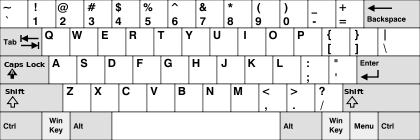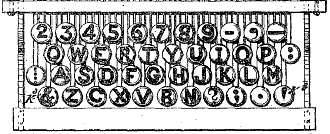History of the QWERTY Keyboard
By Rich Talbot
As children grow up they have to face quite a few disappointments in life. They learn
that pixies, the tooth fairy, and that other guy in the red suit don't exist. They discover
that green vegetables are not merely a garnish; and they encounter the QWERTY keyboard.
The child puts in a great deal of effort going through the daily positive brainwashing
process of learning the letters of the alphabet; a-for-apple, b-for-ball, c-for-cat... until
finally all twenty-six are imprinted in his or her mind in the correct order and a world of
reading and writing awaits. A lot of the latter part of this world will be explored using word
processing packages such as Microsoft Word, and children these days are introduced to these
programs at an early age.

QWERTY keyboard
The child's first encounter with a computer, however, can be something of a shock. Setting
eyes on the keyboard for the first time, the child is aghast to discover that none of the letters
are in their correct places; it is as though someone has made a huge anagram of the alphabet,
and everything the child has learned has flown out of the window.
Gingerly the child sets about typing using this unusual new arrangement, with curled index
finger and protruding tongue a typing speed of 3 - 5 words per minute is reached using the hunt
and peck method. Of course, with practice the child can soon become proficient in using the
keyboard, but why are the keys laid out in this alphabet soup fashion in the first place? The
answer lies way back in the days of the very first typewriters.

Scholes keyboard
In the late 1860s, an American inventor by the name of Christopher Scholes developed
the first rudimentary typewriter with a group of associates. The keys on this early machine
were originally laid out in alphabetical order, but this led to problems with the type bars
jamming when typing at speed. To remedy this, Scholes relocated the keys with the aim of keeping
the most frequently used letters apart, and the result is the QWERTY keyboard.
Not long after this, however, improvements in typewriter design put an end to the jamming
problem, so technically the QWERTY system was no longer necessary, yet it has survived even
into the computer age, where there are no type bars to jam.

Dvorak keyboard
It does have its rivals, however, the best known of which is the Dvorak Simplified Keyboard,
which was patented by August Dvorak in Seattle in 1936. This layout was to challenge, but never
conquer QWERTY, despite having several advantages over it, such as simplicity to learn, increased
comfort when typing and favouring the right hand.
Although this layout bears no resemblance to the familiar QWERTY, it can be mastered
in a short time, and it is worth pointing out that the world record for typing speed, held
by the late Barbara Blackburn who reached a peak speed of a staggering 212 words per minute,
was achieved using the Dvorak system. The Dvorak Simplified Keyboard is available on all major
operating systems, but, despite well-founded claims of superiority in accuracy and ease of
use it has failed to dislodge the stubborn QWERTY layout.
So, having survived for well over a hundred years, does the QWERTY layout on the modern
computer keyboard have anything more to offer than that of early typewriters? Well, yes and no.
| 
